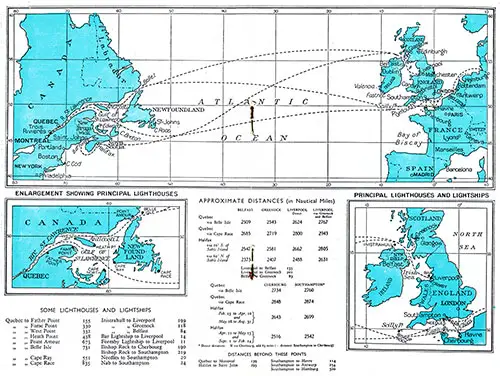SS Montrose Passenger List - 4 August 1939
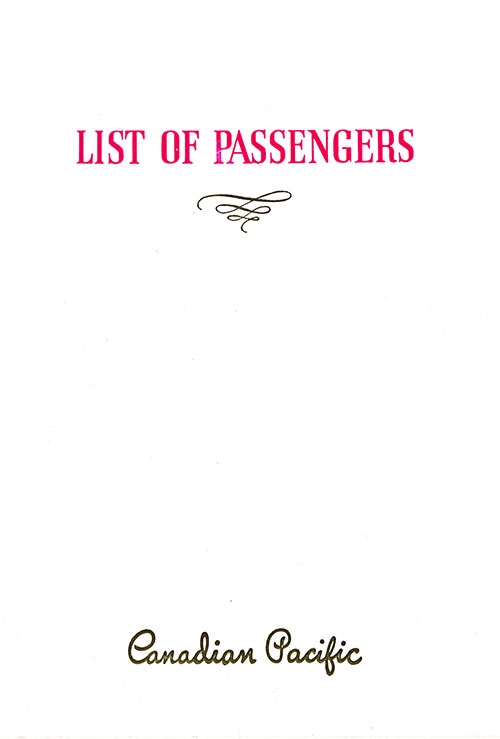
Front Cover, SS Montrose Cabin Passenger List of the Canadian Pacific Line (CPR-CPOS), Departing Friday, 4 August 1939, from Liverpool to Québec and Montréal via Belfast and Greenock, Commanded by Captain H. J. Ferguson, D.S.C. | GGA Image ID # 21289d15a2
Senior Officers and Staff
- Commander: Captain H. J. Ferguson, D.S.C.
- Chief Officer: A. F. Campbell
- Chief Engineer: H. A. Glennie
- Purser: H. M. Taylor
- Junior Purser: A. J. Goldie
- Surgeon: J. M McEwan, M.B., Ch.B.
- Chief Steward: J. Wilson
- Rail Traffic Representative: H. Riddoch
Cabin Passengers
- Mr. D. Amphlett
- Mr. B. Anquetil
- Mrs. Anquetil
- Mrs. A. P. Ashmead
- Miss J. M. Ashmead
- Mr. W. H. Ballantyne
- Mrs. Ballantyne
- Miss G. C. Ballantyne
- Mr. H. N. Ballantyne
- Miss E. Ballard
- Rabbi C. Bender
- Miss B. Beresford
- Mrs. A. Berto
- Miss A. Berto
- Miss Y. Berto
- Mr. H. D. Brunt
- Mrs. Brunt
- Mstr. A. D. Brunt
- Mstr. L. F. Brunt
- Miss A. M. Brunt
- Mrs. M. M. Brydon
- Miss E. H. Brydon
- Mr. F. Calder
- Mrs. Calder
- Mr. H. P. Cannell
- Mrs. Cannell
- Mons. J. L. M. Charpentier
- Mme. Charpentier
- Mr. H. F. Cowan
- Mr. D. Cownie
- Mrs. Cownie
- Mrs. F. E. Cox
- Mrs. K. V. Dawson
- Mr. W. P. de la Haye
- Mrs. De la Haye
- Dr. J. A. Doctor
- Mrs. Doctor
- Mr. S. W. Edwards
- Mrs. Edwards
- Mr. W. L. Emery
- Mrs. G. M. W. Fitzmaurice
- Mr. G. R. Freeman
- Mrs. Freeman
- Dr. E. Glaser
- Dr. W. G. Glassco
- Mr. J. Goldie
- Mrs. J. Goodwin
- Miss E. L. Goodwin
- Miss K. F. Greaves
- Miss E. M. Green
- Miss L. M. Green
- Miss A. Haggart
- Mr. G. W. F. Hampshire
- Mrs. Hampshire
- Mrs. K. E. Hampshire
- Mr. T. W. Harding
- Mr. W. F. Harrison
- Miss J. W. Harrison
- Dr. W. C. B. Harvey
- Mrs. Harvey
- Mr. W. G. Helliker
- Mrs. Helliker
- Miss E. L. Helliker
- Mrs. H. Hirschland
- Miss J. P. Holt
- Mr. P. Hudon
- Mr. T. Hunter, J.P., M.P.
- Mr. J. A. Huston
- Mr. G. Jackson
- Mr. G. T. James
- Mrs. A. M. Jameson
- Miss M. L. E. Jones
- Mrs. Fraser Kelly
- Dr. G. W. Kerby
- Mr. R. R. Labatt
- Mrs. Labatt
- Mr. F. Lane
- Miss F. A. Lane
- Mrs. F. E. Leney
- Miss F. M. Leney
- Mrs. J. M. Long
- Mr. E. F. H. Lundholm
- Mr. R. L. Martinson
- Rev. M. Metayer
- Miss F. E. Metz
- Mr. T. D. Murphy
- Mr. W. Philip
- Dr. A. G. Price
- Mrs. Price
- Miss P. E. Price
- Mr. T. Purkis
- Mr. P. C. Rawling
- Mr. W. A. Rawnsley
- Mr. J. H. Riddel
- Miss F. F. Roller
- Mr. C. C. Ross
- Mr. J. Sagman
- Mr. G. H. Saunders
- Mrs. Saunders
- Miss V. N. Schierwater
- Mrs. R. S. Spurling
- Mrs. O. Stanley
- Mrs. K. W. Stevens
- Miss K. C. Stevens
- Mr. A. J. Taylor
- Mrs. E. C. Temple
- Mr. A. H. Temple
- Major E. W. Tyrrell-Beck, D.S.O., M.C.
- Mrs. Tyrrell-Beck
- Mstr. C. E. Tyrrell-Beck
- Mrs. K. A. Ueno
- Miss H. J. Ueno
- Mons. D. A. Viraut
- Mrs. Claire Wallace
Information For Passengers
INFORMATION BUREAU - The Information Bureau is at your service. The Purser and Assistant Pursers are in attendance to deal with all matters affecting the comfort or interest of passengers.
MEALTIMES - Breakfast Chimes will not be sounded when only one sitting. Passengers should inform the Bedroom Steward when they wish to be called. Chimes are sounded thirty minutes before dinner.
TABLE SEATS - Passengers will obtain their table-seat numbers from the Second Steward in the Dining Saloon
AFTERNOON TEA is served at 4 p.m. on deck and in all the Public Rooms. Children will be served in the Dining Saloon.
PRIVATE DINNERS - Passengers who desire to arrange private dinner parties should apply to the Chief Steward. No charge is made for this service.
ORCHESTRA - The Orchestra plays at Tea and Dinner and for dancing in the evening.
LIBRARY - Books of Fiction and Reference are obtained from the library. The Library Steward sells stamps and provides stationery, telegraph forms, and railway timetables.
THE SHOP—A varied assortment of jewelry, dress goods, confectionery, photographic films, etc., is on sale. A wide range of fancy dress costumes is available for sale or hire.
DECK CHAIRS, RUGS, AND CUSHIONS—Deck Chairs, Rugs, and Cushions (with loose covers) may be rented on board for the voyage. Apply to the Deck Steward.
BATHS - The time that baths are desired should be arranged with the Bedroom Steward or Stewardess.
DIVINE SERVICE will be held in Dining Saloon on Sunday at 10:45 a.m.
Altars are carried for the celebration of Holy Mass or Holy Communion.
THE SURGEON is authorized to make customary charges for his services, subject to the approval of the Captain.
NURSES - The services of trained and qualified hospital nurses, under the direction of the Surgeon, may be obtained.
ROTARIANS are invited to inspect the Rotary Register in charge of the Librarian, and subscribe their names. The Purser, providing circumstances permit, will gladly arrange an informal meeting during the voyage.
VALUABLES AND MONEY—In their interest, passengers are advised not to leave articles of jewelry or other valuables lying about. For the convenience of passengers, the Purser will receive articles of value or money for custody in a special envelope that will be sealed in the presence of the passenger. A receipt will be given, but as no charge is made for this facility, the Company accepts no liability.
CHANGE OF ACCOMMODATION—Passengers who desire a transfer should apply to the Purser, who alone can make changes. If higher-graded accommodation is desired, the difference in fare must be paid.
Money Exchange The Purser can exchange a limited amount of currency against Letters of Credit or cash Travelers’ Cheques. The latter are also on sale at his office.
CHEQUES - Passengers are respectfully advised that the Purser has no authority to accept private cheques for payment of accounts or for exchange.
PASSPORTS—Passengers traveling to or through the United States are requested to call the Purser’s Office with their passports as soon as possible.
POSTAGE STAMPS are on sale in the Shop. English or Canadian stamps may be used for mail posted at sea.
SUGGESTIONS - The Canadian Pacific invites suggestions for improvement of the service. Passengers are requested to make suggestions to the Captain, Purser, or Chief Steward promptly so that immediate attention may be given.
AEROPLANE SERVICE - Rail Traffic Representatives have tariffs and can supply the information required.
RETURN ATLANTIC PASSAGE - The Rail Traffic Office is equipped to furnish full information concerning sailings and bookings on Canadian Pacific Steamships. Reservations can be secured, and deposits to cover will be received.
STENOGRAPHER - An experienced stenographer is available to undertake work for passengers. Apply to the Information Bureau for rates.
LIFE BELTS are in all staterooms. Bedroom Stewards will explain method of attachment.
EMERGENCY STATIONS - Passengers are requested to consult plans and directions in alleyway for Emergency Stations.
STORING BAGGAGE - Trunks which passengers do not require in their staterooms during the voyage may be stored in the Baggage Room.
BAGGAGE LABELS, ETC. - Labels and Tags may be obtained upon application to the Bedroom Steward. Upon arrival in the Customs Shed at the Canadian port, baggage will be grouped alphabetically, and passengers must personally attend the Customs examination. After passing the Customs examination, baggage may be checked upon presenting a railway ticket to an inland destination.
BAGGAGE DELIVERY—Passengers who so desire may arrange for delivery of their baggage directly to their residence, hotel, railway station, or steamship wharf in or at any principal Canadian or United States city to which railway transportation is held. Application should be made to the Baggage Checker.
BAGGAGE INSURANCE - Passengers are recommended to insure their baggage, as the Company’s liability is strictly limited, in accordance with the contract ticket. Baggage insurance can be arranged at any Company’s offices or the Rail Traffic Office on board.
MAIL, CABLES, AND TELEGRAMS EXPECTED - Passengers are requested to enquire about mail. They are also invited to leave their addresses at the Information Bureau so that all undelivered mail, telegrams, etc., may be forwarded. Mail matters may be sent to any Canadian Pacific Office—see the list on the last page. Passengers are requested to note that the Company does not undertake to accept delivery of parcels in Great Britain and Northern Ireland if the value of the contents is to be paid on delivery unless prior arrangements are made. Mail and Telegrams for passengers at the port of debarkation will be found in the mail booth at the Customs Shed.
MAIL, CABLES, AND MESSAGES FOR DESPATCH—The Information Bureau accepts mail, cables, and wireless messages for dispatch. Cablegrams and telegrams should be handed in at least an hour before arrival at any port of call. None of the ship’s employees, except those on duty in the Information Bureau, are authorized to accept letters, cables, and telegrams for dispatch.
WIRELESS TELEGRAMS - Information and rates will be furnished at the Purser’s Bureau. The ship is fitted with wireless installation, permitting communication with both sides of the Atlantic at any time during the voyage. Attention is drawn to special facilities for cheap rates for ocean “poste” and ocean letters.
DECK GAMES AND HOW TO PLAY THEM
Games on board ship differ, of course, from those ashore, and the following explanation of some of the more popular deck games may prove useful, especially to first voyagers.
DECK TENNIS - One of the most popular of deck games.
- The game is played and scored in the same manner as Tennis, using a rubber quoit instead of a ball.
- Toss for choice of ends, and change ends after 1st, 3rd and 5th games. Losers of toss have first serve.
- Service is from behind the back line and in the same order as in Tennis.
- Service must be into the Court diagonally opposite.
- The server is allowed two smooth underhand serves, a serve touching the net but being otherwise good is counted as a “let” and may be played over again.
- The quoit must be caught with one hand only and must not touch the body or other obstruction.
- Receiver of service must stand back on “receiving line,” but may run up as soon as the quoit has left the server’s hand.
- The return must be made without any undue delay and from where the quoit was caught.
- All serves and returns must be made underhand (the hand throwing the quoit must not be raised higher than the shoulder) and the quoit must have an upward tendency, rising at least 6 inches after leaving the hand. There is no restriction on “cutting” or “spinning” returns.
- A return touching the net but falling within the boundaries of the Court is counted as good.
- A player must not reach over the net to catch or return the quoit, nor step into the “dead area.”
- A quoit falling in the “dead area” under the net counted as out.
- Should any obstruction in the vicinity of the boundary lines of the court render the receiving of a quoit impossible, such throw shall be counted as a “let.”
SHUFFLEBOARD - Especially popular as a Mixed Doubles game. Rules are as follows:
- The game is for four players who, with the aid of a wooden shovel, endeavor to slide a wooden disc on to a numbered target.
- Toss for first “shove” and thence the winner of the end starts.
- Discs that do not cross the line in front of the target are removed.
- When shooting, the player must not step in front of the service line.
- In the event of a foul shot striking any quoits they are to be replaced by the Umpire.
- The “10 off” is added to the opponent’s score.
- In order to score, a disc must be exactly inside a square. If it touches any of the bounding lines it does not count.
- Game is 51 up.
The following illustration will be helpful:

BULLBOARD
- The game is played by two players, who endeavor to throw discs into the squares on the bullboard.
- Toss for first throw.
- The order of play is from 1 to 10 in sequence, left-hand bull, right-hand bull, and then in reverse order from 10 to 1.
- Should a player inadvertently throw on to a bull he is penalized one number, e.g., if in trying for number 3 he lands on the bull, he is obliged to try for number 2 again.
- A disc touching a line does not score, but, as the discs lie upon the board until the player’s turn is completed, one disc may drive another from a line into a division, and thus score.
- The winner is he who completes the course first, but each player must have an equal number of throws.
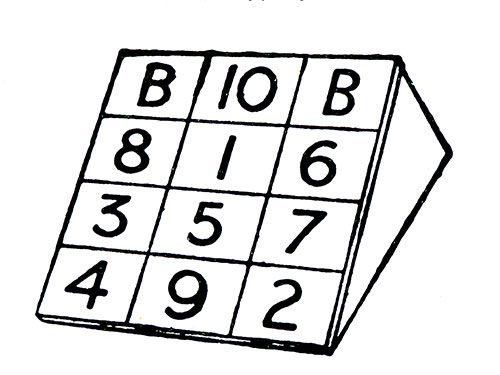
DECK QUOITS (Jack Game)
- The game is played with a “running jack” in the same manner as bowls, the object being to get a good quoit in and then cover in order to prevent your opponent knocking it away
- Toss for first throw and thence the winner of the end commences.
- Only quoits within 3 feet oil the Jack score.
- If a quoit touches anything on its passage it is to be reckoned as dead and removed.
- The quoit must be pitched and not skidded along the deck. A dotted line is marked at approximately half-way down the pitch over which the quoit must be thrown. Quoits falling short of, or touching, this dotted line are to be removed and any quoits they displace are to be replaced.
- In the event of the Jack being knocked into an unplayable position, that particular game is cancelled and a fresh start made.
- Game is 21 points.
There is another method of play called “ Ring Game.”
TABLE TENNIS
- The game is played by two or four players, who toss for choice of ends or service. The winner of the toss may choose the end from which he wishes to play or first service.
- The server must: (a) Stand behind the base line and between an imaginary extension of the side lines; (b) Throw the ball into the air or drop it before striking it with the bat; (c) Strike the ball in such a manner that it bounces on the server’s side of the net before jumping over the net into the opponent’s area.
- The return must be hit over the net or round the posts into the opponent’s area. There is no penalty if the ball touches the net or posts in so doing.
- A shot is a “let” if the service ball touches the net or posts but is otherwise good, and also if the server serves before the opponent is ready to receive.
- The game is for 21 points. In the case of both players scoring 20 points each, then the game to be decided by best out of five points.
- The service is changed after every 5 points and in the case of 20-all the service changes after every point.
- A player is not allowed to touch the table with any part of the body or free hand whilst the ball is in play.
- It is customary to play the best of 3 games, in which case the players change ends after every game.
MINIATURE HORSE RACING
The course is marked off with white lines on green canvas. It is 38 feet by 5 feet and is laid out on the deck. It is divided in its length into nineteen spaces, each 2 feet long. The first space is marked “Starting Station” and the next space “ 1,” the remaining spaces being marked with consecutive numbers up to “ 18.”
The eighteenth space is also marked “Finish.” The numbering reads from right to left. Six parallel lines, 10 inches apart, extend the length of the course and arc marked with consecutive numbers, from “1” to “ 6,” and reading right to left when looking down the course.
Six horses, each painted a different color and marked with a separate number, from “1” to “6,” arc arranged at the “Starting Station,” the number of the horse corresponding to the number on the line. For steeple chasing, six hurdles are arranged down the course and equally spaced three spaces apart.
Three dice are used for flat racing, four for steeple chasing.
Method of playing:
Flat Racing.—Six persons play this game, each person having one horse. The game is in charge of a manipulator chosen by the players, to whom all questions concerning the game must be referred. The three dice are thrown and the numbers which come uppermost are called out by the manipulator. The horses whose numbers are called move forward. Each horse moves forward one space every time its number is called. As many times as a horse’s number is called with one throw of the dice, the horse moves forward that number of spaces. The first horse to reach “Finish” to be adjudged the winner.
Steeplechase Racing.—Four dice to be used. Proceed as in flat racing, but the number of the horse must be called twice in one throw of the dice after it arrives at the hurdle, before it can move one space forward.
Various other deck games are also available, and enquiry should be made of the Deck Steward.
INDOOR GAMES
The following indoor games are available on application to Lounge or Smokeroom Stewards: Chess, Draughts, Cribbage, Dominoes, Dice, Poker Dice, Backgammon, Poker Chips, Keno.
Some Interesting Sea Facts
DISTANCES VISIBLE AT SEA
At an elevation of 5 feet, one can see 2.6 nautical miles; at 20 feet, 5.1 miles; at 35 feet, 6.8 miles; at 50 feet, 8.2 miles; and 100 feet, 11.5 miles.
DISTANCES MEASURED BY SOUND
If the steam from a distant ship's whistle is seen, and if ten seconds elapse before the sound is heard, the ship is just 2 1/10 miles off. If one second elapses, she is distant slightly more than one-fifth of a mile; if five seconds, a little more than 1 mile; if twenty seconds, 4 1/5 miles.
WATCH AS A COMPASS
Point the hour hand of the watch to the sun. The south is then exactly half-way between the hour hand and the 12 on the watch. For example, assuming it is 9 o’clock, point the hour hand (indicating 9) to the sun, and due south is then exactly half-way between the figures 10 and 11. Similarly, at 4 o’clock, south lies over the figure 2. For a.m. times, of course, you should read forwards to 12—for p.m. times, backwards.
NAUTICAL MILES
The statute mile is 5,280 feet.
The nautical mile is one sixtieth of a degree of latitude, and varies from 6046 feet at the Equator to 6092 feet at latitude 60. It is generally interpreted at 6080 feet, which is the Admiralty “measured mile” for speed trials.
6 feet—1 fathom.
600 feet (approx.)—1 cable.
10 cables—1 nautical mile.
1 nautical mile—1.15 statute mile.
WHAT IS A KNOT?
The “knot” is not a measurement of distance but of speed. “One knot” means one nautical mile per hour.
TONNAGE
There are three kinds of measurements of ships by tonnage— gross tonnage, net tonnage, and displacement tonnage.
Gross tonnage is the total internal capacity below the upper deck and of all enclosed deck houses above it, measured in tons of 100 cubic feet. For example, 4,250,000 cubic feet equals 42,500 Gross tons.
Net tonnage is obtained by subtracting from the gross tonnage all spaces used for the accommodation of the officers and crew, for gear necessary for the ship's operation, and for machinery, including boilers and engines.
Displacement tonnage is the total weight of water a ship displaces when loaded to its utmost capacity.
Customs Regulations — Canada
GENERAL—All baggage is subject to examination, and non-resident passengers are required to declare at the port of landing all articles in baggage or on their persons that do not constitute wearing apparel, articles of personal adornment, toilet articles, or similar personal effects, whether intended for their own use or for others. When in doubt whether or not an article is liable to duty, it should be produced for examination.
RESIDENTS OF CANADA - Residents of Canada must declare all articles acquired abroad, contained in baggage, or on their persons, whether intended for personal or household use or as souvenirs or gifts. Exemption will be allowed of such articles to the extent of $100 in value for each person, provided they are not bought on commission or as an accommodation for other persons or sale, subject to the following: —
- Each returning Canadian citizen must complete a declaration form supplied by the Purser enumerating all articles acquired abroad for which the intention is to claim exemption. If a family is traveling together, each member must complete a separate declaration. Exemption will not be granted to any person under fourteen.
- The declaration must be completed in duplicate.
- A declaration need not be completed unless the total value of goods upon which an exemption is claimed exceeds $5.
- Important. For convenience, all new goods on which exemption is claimed should be packed in one receptacle, preferably a heavy piece of baggage.
- All values should be shown in Canadian currency.
- Declaration should be completed before arrival at the landing port and handed to the officer during inspection.
TOURISTS’ OUTFITS / TEMPORARY ADMISSION - Persons visiting Canada for a limited period, for health or pleasure, may bring with them such articles of tourists’ outfits or sportsmen’s equipment as they may require while in Canada for their use and not for gain or hire, upon reporting same to the Customs Officer at the Canadian frontier port of entry.
THROUGH BAGGAGE—Passengers en route to destinations outside Canada may have their checked baggage forwarded “In Bond” to a frontier port under the Customs Manifest without examination.
SAMPLES—Samples carried by commercial travelers must be delivered to the Customs Officer for entry purposes. An invoice or statement in detail showing the wholesale price of each sample sold for home consumption must accompany the shipment. The traveler should attest to the invoice or statement.
Customs Regulations —United States
UNITED STATES CUSTOMS - Inspectors are located at Canadian Atlantic Ports but are not permitted to collect dues. To avoid complications and payment of duties to Canadian Customs, citizens of the U.S. returning from Europe should pack new goods purchased or otherwise acquired abroad in one or more receptacles, which may be checked on landing and forwarded in bond to the destination.
CHECKED BAGGAGE not containing dutiable articles or new goods above the exemption to which the owners may be entitled will be examined by the U.S. Customs Inspectors, and no further examination will be made at the U.S. frontier or destination.
Canadian Customs does not examine such baggage. Hand baggage should not contain dutiable articles. It will be examined by Canadian Customs on landing and by U.S. Customs Inspectors on the train at the U.S. border.
Purser will issue passengers for the U.S. with a U.S. Customs Baggage Declaration form for completion in duplicate and for presenting to the U.S. Customs Inspector at examination time. Values must be shown in U.S. currency.
RETURNING RESIDENTS of the U.S. must declare all articles acquired abroad, in baggage, or on their persons, whether by purchase, gift, or otherwise, and whether dutiable or free of duty.
Exemptions will be allowed by Customs Officers of articles aggregating not over $100 in value, if for personal or household use or as souvenirs or curios, and whether intended for personal use of passengers or as gifts or presents to others, provided articles are not bought on commission for another person nor intended for sale.
Articles so exempt from duty must, nevertheless, be declared. Each family member is entitled to an exemption of $100 for articles purchased abroad, and when a husband and wife and minor and dependent children travel together, articles may be grouped, and an allowance may be made to one member.
ARTICLES FROM ABROAD - Articles acquired abroad shipped from the port of landing to destinations in the U.S. by express should be declared to the U.S. Customs Inspector in charge at the port of Landing and also to the Inspector on the train at the U.S. border for duty exemption to which owner may be entitled.
Non-residents of the United States destined to that country must declare all articles in baggage or on their persons which do not constitute wearing apparel, articles of personal adornment, toilet articles, or similar personal effects, WHETHER INTENDED FOR THEIR PERSONAL USE OR FOR OTHERS. THEY MUST ALSO declare all articles of wearing apparel, jewelry, and other articles of personal adornment, toilet articles and similar effects WHEN NOT OWNED BY THEM.
Professional books, implements, instruments, and tools of trade, occupation or employment, in actual possession of persons emigrating to United States, owned and used by them abroad, are admitted free of duty.
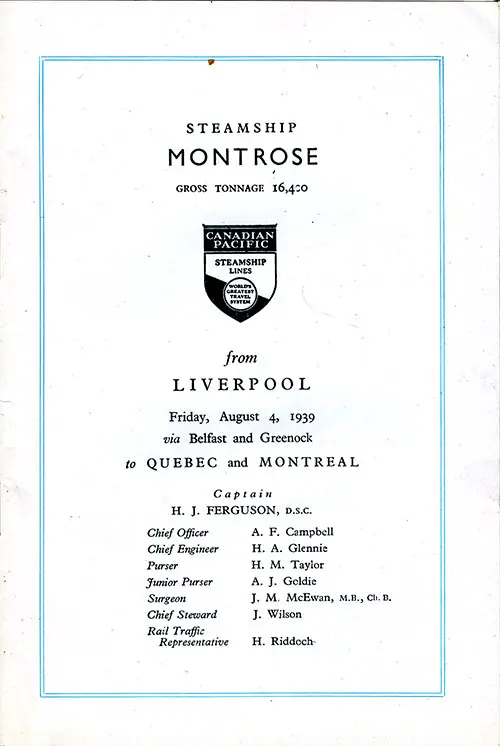
Title Page Including Listing of Senior Officers and Staff, SS Montrose Cabin Passenger List, 4 August 1939. | GGA Image ID # 2128c2c86e
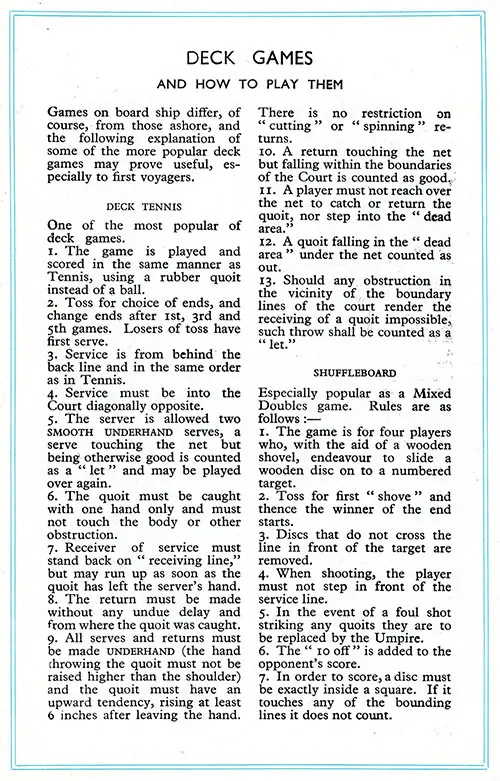
Deck Games and How to Play Them, Part 1 of 3. SS Montrose Cabin Passenger List, 4 August 1939. | GGA Image ID # 2128ca63dc
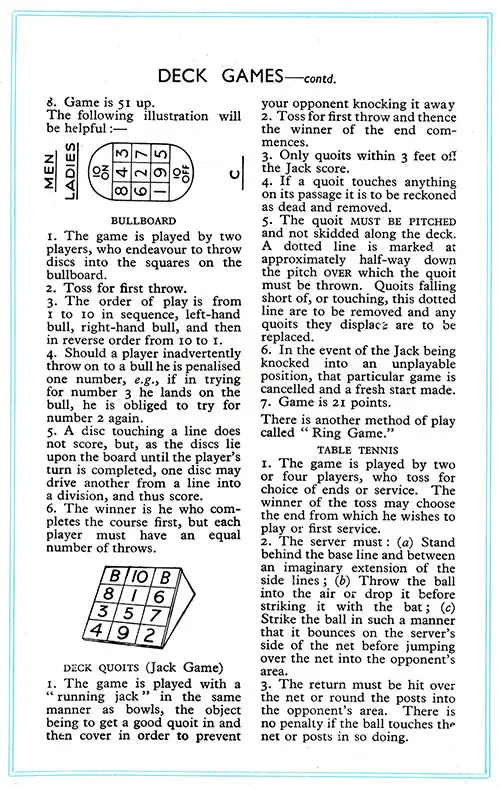
Deck Games and How to Play Them, Part 2 of 3. SS Montrose Cabin Passenger List, 4 August 1939. | GGA Image ID # 2128cb6820
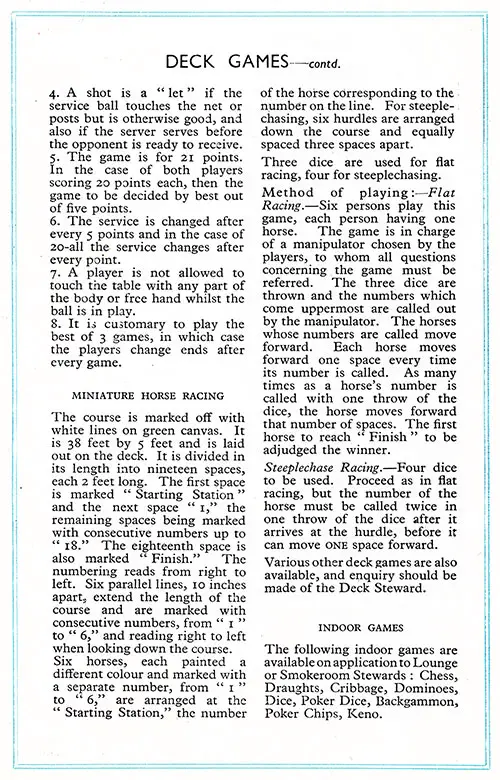
Deck Games and How to Play Them, Part 3 of 3. SS Montrose Cabin Passenger List, 4 August 1939. | GGA Image ID # 2129863114
Track Chart, Maps of Principal Lighthouse and Lightships Near Canada and the British Isles, Table of Some Lighthouses and Lightships, and Approximate Distances in Nautical Miles. SS Montrose Cabin Passenger List, 4 August 1939. | GGA Image ID # 2129ab6733. Click to View Larger Image.
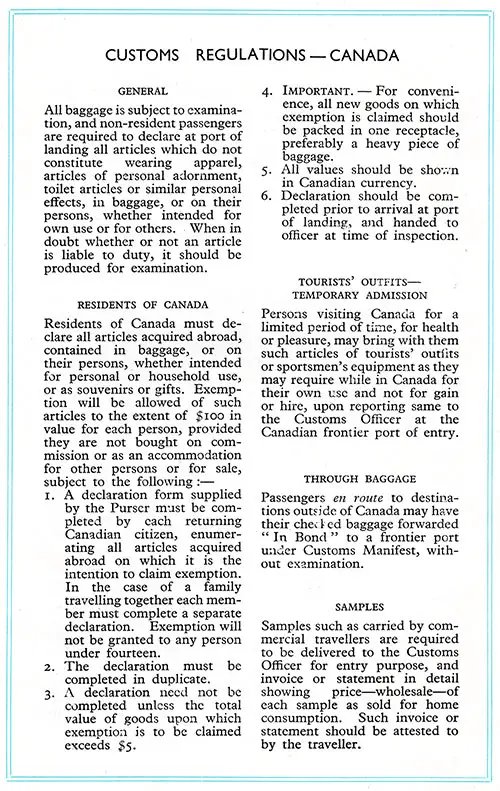
Canadian Customs Regulations (1939). SS Montrose Cabin Passenger List, 4 August 1939. | GGA Image ID # 212a3df646
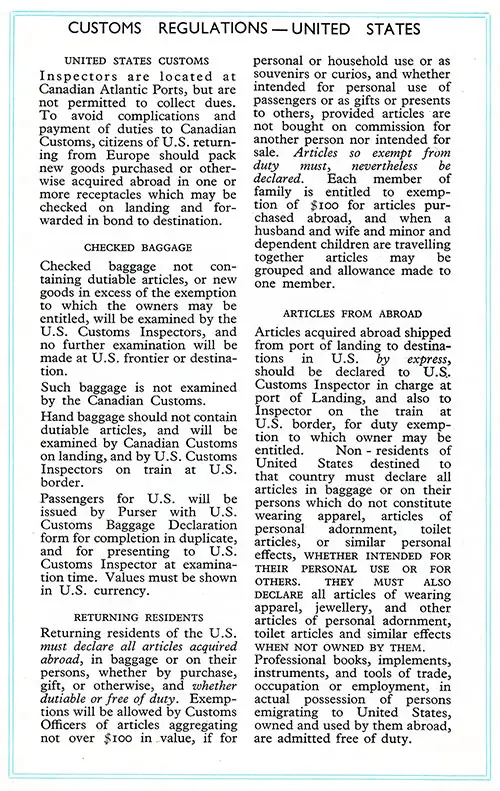
US Customs Regulations (1939). SS Montrose Cabin Passenger List, 4 August 1939. | GGA Image ID # 212a4d6012
Passenger List Images Contributed by Chris Crofts, 2023-2024.
📜 Research note: Some names and captions were typed from originals and may reflect period spellings or minor typographical variations. When searching, try alternate spellings and cross-check with related records. ⚓
Curator’s Note
For over 25 years, I've been dedicated to a unique mission: tracking down, curating, preserving, scanning, and transcribing historical materials. These materials, carefully researched, organized, and enriched with context, live on here at the GG Archives. Each passenger list isn't just posted — it's a testament to our commitment to helping you see the people and stories behind the names.
It hasn't always been easy. In the early years, I wasn't sure the site would survive, and I often paid the hosting bills out of my own pocket. But I never built this site for the money — I built it because I love history and believe it's worth preserving. It's a labor of love that I've dedicated myself to, and I'm committed to keeping it going.
If you've found something here that helped your research, sparked a family story, or just made you smile, I'd love to hear about it. Your experiences and stories are the real reward for me. And if you'd like to help keep this labor of love going, there's a "Contribute to the Website" link tucked away on our About page.
📜 History is worth keeping. Thanks for visiting and keeping it alive with me.

